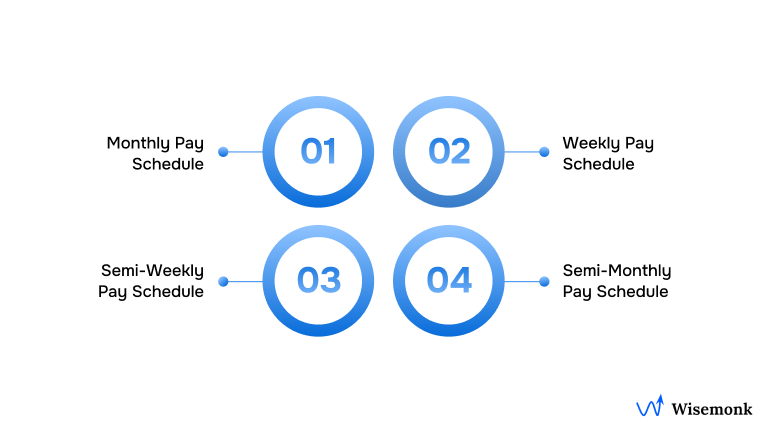- Biweekly pay is a payroll schedule where employees are paid every two weeks, resulting in 26 paychecks per year, providing regular income and simplifying payroll management.
- For salaried employees, divide the annual salary by 26 for biweekly pay calculations. For hourly employees, multiply hours worked by the hourly rate to determine pay.
- Biweekly pay offers predictable income and extra paychecks, simplifying budgeting and overtime tracking. However, it results in smaller paychecks, challenges with monthly bills, and increased administrative work for employers.
- The main difference between biweekly and semi-monthly pay is that biweekly pay has 26 paychecks per year, paid every two weeks, while semi-monthly pay has 24 paychecks, paid on fixed dates each month.
Curious about how bi-weekly pay can benefit your business? Contact us today!
Discover how Wisemonk creates impactful and reliable content.
If you're wondering how many paychecks a year employees receive on a biweekly pay schedule, the answer is 26. Many U.S. and global businesses find payment schedules challenging to navigate. Whether you're deciding if biweekly pay is the right fit for your team or trying to understand how your paycheck will be structured, it can feel overwhelming.
In this article, we’ll explain what biweekly pay is, compare it with other payment schedules, discuss its pros and cons, and show you how to calculate it, helping you make informed decisions. Let’s dive in!
What is biweekly pay?[toc=Bi-Weekly Pay]
Biweekly pay refers to a payroll schedule where employees receive their wages every two weeks. This payment cycle results in 26 paychecks per year.
The U.S. payroll compliance is governed by several federal and state laws to ensure employees are paid fairly and on time. The Fair Labor Standards Act (FLSA) sets basic rules for minimum wage, overtime, and recordkeeping.
Employers must also adhere to state-specific wage laws, which can vary regarding pay frequency, overtime regulations, and deductions, to avoid penalties and legal issues.
How biweekly pay works
A biweekly pay schedule means employees are paid every two weeks, resulting in 26 pay periods per year. Here's a detailed breakdown:
- Frequency: Employees are paid every two weeks, resulting in 26 pay periods in a 52-week year.
- Paychecks per Month: Typically, you will receive two paychecks per month. However, since 26 pay periods don’t evenly divide into 12 months, two months in the year will have three paychecks.
- Budgeting: The consistency of biweekly pay can help with budgeting. The extra paycheck in certain months provides an opportunity to save or pay off debt.
- Tax compliance: Employers manage payroll taxes, tax compliance, and benefits based on the biweekly schedule, which can differ from monthly or semimonthly calculations.
Industries that commonly use biweekly pay
Certain sectors rely heavily on biweekly payments to streamline payroll. Here’s a quick overview:
- Education and Health Services: Approximately 63.6% of establishments in this sector utilize a biweekly pay period.
- Leisure and Hospitality: Around 54.9% of businesses in this industry opt for biweekly pay.
- Information: About 47.2% of establishments in the information sector use biweekly pay schedules.
These industries favor biweekly pay due to the balance it offers between processing efficiency and employee satisfaction. It provides employees with a predictable payday while allowing employers to streamline payroll operations. Read more on the U.S. Bureau of Labor Statistics.
What are the pros and cons of bi-weekly pay for employers?[toc=Pros & Cons: for employers]
With our experience in supporting businesses with payroll processing and tax compliance, here’s an overview of the key pros and cons of adopting a biweekly pay schedule for employers:
What are the pros and cons of bi-weekly pay for employees?[toc=Pros & Cons: for employees]
Based on our experience assisting businesses with payroll solutions, here’s an overview of how a biweekly pay schedule impacts employees, covering both the benefits and potential challenges.
Now that we’ve covered the pros and cons for both employees and employers, let’s dive into how biweekly pay is actually calculated.
How is bi-weekly pay calculated?[toc=How is it Calculated]
Understanding how bi-weekly pay is calculated ensures accurate paychecks and proper payroll processing. Through our experience in helping businesses with payroll processing and tax compliance, here’s a step-by-step guide to calculating bi-weekly paycheck for both salaried employees and hourly workers.
is it necessary to add opening sentence after the three H3's: for salaried employees, for hourly, overtime calculations
For salaried employees
To calculate biweekly pay for salaried employees, you need to divide the annual salary by the number of biweekly pay periods in a year.
- Determine the Annual Salary: Take the employee's annual salary (e.g., $60,000).
- Divide by 26: Since there are 26 biweekly periods in a year, divide the annual salary by 26.
- Example: $60,000 ÷ 26 = $2,307.69 per paycheck.
For hourly employees
For hourly employees, calculate biweekly pay based on their hourly rate and hours worked over the two-week period.
- Determine the Hourly Rate: Find the employee’s hourly earned wage (e.g., $15/hour).
- Calculate Hours Worked: Multiply the hourly rate by the number of hours worked per week (typically 40 hours per week).
- Example: $15 x 40 = $600 per week.
- Multiply by 2: Multiply the weekly pay by 2 for the biweekly total.
- Example: $600 x 2 = $1,200 per paycheck.
Overtime calculations
For employees who qualify for overtime pay, this needs to be calculated separately based on the overtime rate.
- Identify Overtime Rate: Overtime is usually paid at 1.5 times the hourly rate (e.g., $15 x 1.5 = $22.50/hour).
- Calculate Overtime Hours: Determine how many overtime hours the employee worked in the pay period (e.g., 10 overtime hours).
- Calculate Overtime Pay: Multiply overtime hours by the overtime rate.
- Example: 10 hours x $22.50 = $225 overtime.
- Add Overtime to Regular Pay: Add the overtime pay to the regular biweekly paycheck.
- Example: $1,200 + $225 = $1,425 total pay.
By following these steps for both salaried and hourly employees, you can ensure accurate biweekly pay calculations, helping maintain a smooth payroll cycle and compliance with tax regulations.
How does biweekly pay differ from other pay schedules?[toc=Comparisons]

When choosing a payroll schedule, organizations often consider options beyond biweekly pay. The best choice depends on factors like payroll policies, cash flow, and applicable labor laws.
Below are some standard alternative pay schedules:
Monthly pay schedule
Payroll is processed 12 times a year on fixed dates. This method is cost-effective for employers due to its reduced number of pay periods. However, employees receive their wages only once a month, which may make budgeting more challenging.
Weekly pay schedule
Employees are paid every week, resulting in 52 paychecks annually. While this offers frequent payment for workers, it increases payroll processing costs and administrative workload. Weekly pay is often used for contract or freelance workers with irregular or hourly work.
Semi-weekly pay schedule
In this schedule, employees are paid twice a week, usually every two or three days. This frequency can create a significant administrative burden, making it less common in many organizations.
Semi-monthly pay schedule
This schedule processes payroll twice a month, typically on set calendar dates (e.g., the 15th and 30th). It involves fewer pay periods than biweekly payroll and offers predictability in processing, making it a preferred choice for some employers.
Here’s a table summarizing the differences among the four pay schedules:
This table highlights the trade-offs in payroll frequency, administrative effort, and employee payment timing for each schedule.
What are the differences between biweekly pay and semi-monthly pay?
The primary difference between biweekly and semi-monthly pay lies in the frequency of payments. On a biweekly schedule, employees receive 26 paychecks per year, with payments issued every two weeks. This means that, in two months each year, employees will receive three paychecks instead of the usual two.
In contrast, a semi-monthly schedule provides 24 paychecks per year, with payments issued on fixed dates, typically the 15th and the last day of each month. Although both schedules result in the same total annual pay, the timing differs: biweekly pay results in more frequent payments throughout the year, while semi-monthly pay maintains fixed payment dates each month.
If you're unsure which pay cycle best suits your business, or need more detailed insights on which industries commonly use each type, check out our article on "Understanding Pay Cycle: Meaning and Types".
How do You transition to a biweekly pay schedule?[toc=How to Switch]
Based on our experience helping companies with payroll processing and tax compliance, here’s a step-by-step guide on how to effectively transition to a biweekly pay schedule.
provide a short intro or opening sentence after each three H3
Steps for employers
Before switching to a biweekly pay schedule, employers need to take certain steps to ensure a smooth transition and avoid payroll errors.
- Evaluate Current Payroll System: Review your existing payroll process and how it aligns with biweekly pay.
- Choose a Transition Date: Pick a clear start date for the switch to biweekly pay. Ensure it's a pay period that minimizes confusion.
- Adjust Payroll Software: Update payroll software or systems to handle the new biweekly schedule.
- Notify Third-Party Vendors: Inform any payroll service providers, accountants, or banks involved in processing pay.
- Run Test Calculations: Do a trial run to ensure calculations are accurate and to resolve any issues before going live.
Communicating with employees
Clear communication with employees is essential to avoid confusion and help them adjust to the new pay schedule.
- Provide Early Notice: Inform employees well in advance about the change to allow them time to adjust.
- Explain the Benefits: Highlight the advantages, such as predictable income and occasional extra paychecks.
- Be Transparent: Address any concerns, particularly about how the transition will affect their paychecks and budgeting.
- Offer Support: Provide resources, such as FAQs or dedicated support, to answer employee questions during the transition.
Legal and compliance considerations
Ensuring compliance with state and federal regulations is critical when transitioning to a biweekly pay cycle.
- State and Federal Laws: Ensure the new schedule complies with state labor laws and federal regulations on pay frequency.
- Review Contracts: Examine employment contracts to verify that switching to biweekly pay does not violate any terms.
- Update Policies: Revise any company policies, such as those related to overtime or benefits, to reflect the new pay schedule.
- Tax Implications: Confirm the new pay schedule aligns with tax withholding rules, especially if it affects tax calculations.
If you're planning to switch payroll companies, you might be interested in this as well. Check out our article on "Switching Payroll Companies".
What are the tax implications of biweekly pay?[toc=Tax Implications]
Biweekly pay results in minor fluctuations in the amount withheld per paycheck, but the total annual tax withholding remains the same. Employers adjust the withholding amount based on the number of pay periods, ensuring that the total tax withheld matches the employee's tax liability for the year.
While the per-paycheck withholding may vary, the overall tax burden depends on total annual income, not the pay frequency. Being paid biweekly simply spreads the tax payments across the year.
Ensuring accurate tax management is essential for employers to maintain compliance and avoid penalties under a biweekly payroll system. Next, let’s explore how biweekly payroll compares to other common pay schedules.
What are common misconceptions about bi-weekly pay?[toc=Common Misconceptions]
There are several common misconceptions about bi-weekly pay that can cause confusion for both employees and employers.
Based on our experience in helping companies with payroll processing, here’s a closer look at the most common misconceptions surrounding biweekly pay and how they impact businesses and employees.
Biweekly Pay Equals Monthly Pay
Many people mistakenly believe that biweekly pay is the same as monthly pay, but they are different.
Biweekly pay means employees receive 26 paychecks a year, while monthly pay only has 12 paychecks. As a result, each biweekly paycheck is typically smaller than a monthly paycheck, even though the total annual salary remains the same.
More Pay Periods Mean More Pay
Some believe that having more pay periods means they’ll earn more money, but that’s not the case. The total annual salary or hourly wage stays the same, regardless of the number of paychecks. The only difference is how it’s distributed.
Biweekly Pay Is Always Better
While biweekly pay offers regular paychecks, it’s not always better for everyone. It can cause challenges with budgeting, especially for employees used to managing monthly payments or those who have fluctuating income needs.
By addressing these misconceptions, businesses and employees can make more informed decisions about adopting a biweekly pay schedule, ensuring smoother payroll operations and better financial planning.
How can you optimize your payroll and compliance with Wisemonk?[toc=How Wisemonk Helps]
Wisemonk is a trusted Employer of Record (EOR) in India, helping businesses hire, pay, and manage talent efficiently. We handle payroll, taxes, and compliance across borders, ensuring smooth operations for global teams.
Here’s how Wisemonk helps:
- End-to-End Payroll Services: Automated payroll management ensuring accuracy and compliance with regional tax laws.
- Real-Time Compliance Updates: Stay informed of any regulatory changes that affect your workforce.
- Cost-Efficient Solutions: Save time and resources by outsourcing payroll and compliance tasks to experts.
By leveraging Wisemonk, you can optimize your payroll processes, minimize risks, and ensure seamless compliance, allowing you to focus on building high-performing global teams.
Partner with Wisemonk to simplify your hiring and payroll compliance. Contact Wisemonk today to streamline your payroll and focus on growing your business.
.webp)






%20(3).webp)